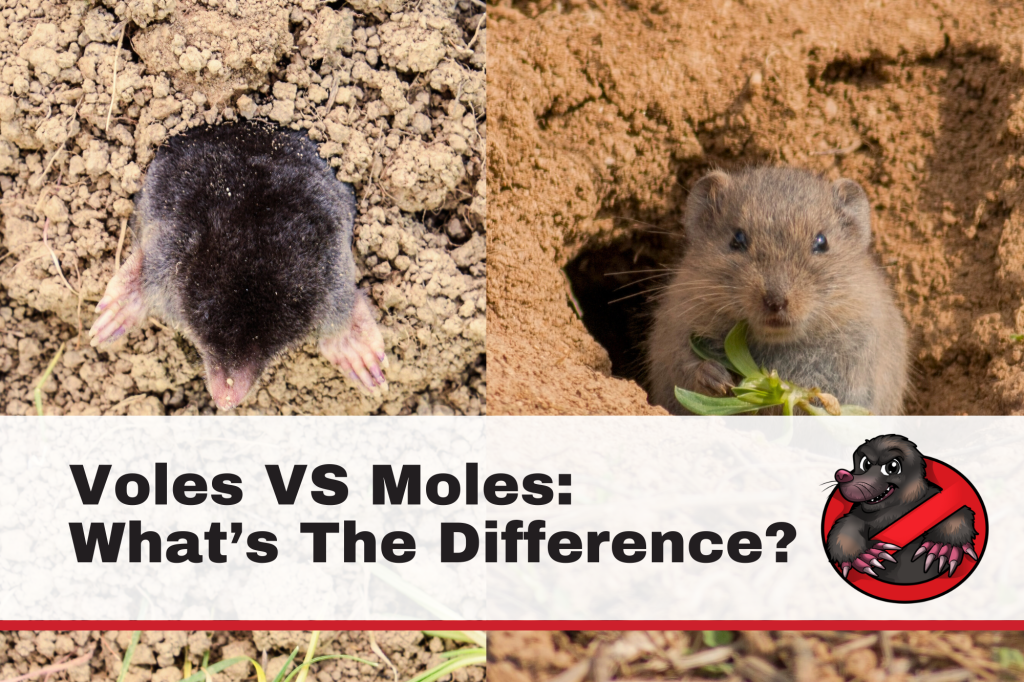Voles VS Moles: What’s The Difference?
If you’re dealing with a yard full of unsightly holes or damaged plants, you might be wondering if you’re facing a mole or vole problem. Both pests can wreak havoc on lawns and gardens, but they are quite different in their habits and the type of damage they cause. Knowing the difference is crucial to choosing the right control strategy, especially in Western Washington, where both moles and voles can be common.
From a visual perspective, these small critters look quite similar. Only a few inches long, they can be found wreaking havoc in gardens and lawns. They are covered in short brown fur and have pointy little faces. For the average person, it can be difficult to tell the difference.
What Are Moles?
Moles are small, burrowing mammals that are about 4-7 inches long. They have pointed snouts, large, paddle-like front paws for digging, and tiny eyes that are not always visible. Moles are insectivores, meaning they feed primarily on insects, worms, and other invertebrates found underground. Their tunnels are often the result of their search for food, and while these tunnels might make your lawn bumpy, moles are not directly eating your plants.
Key Signs of Moles:
- Mounds of Soil: Moles push dirt to the surface as they dig, leaving behind volcano-shaped mounds.
- Raised Tunnels: You may notice raised ridges or tunnels running through your lawn.
- Lawn Disruption: Though they don’t eat plants, their tunneling can disrupt root systems, making the lawn uneven and unsightly.
What Are Voles?
Voles, also known as field mice, are small rodents similar in size to regular mice, usually 3-5 inches long. Unlike moles, voles are herbivores and feed on plants, including roots, bulbs, and grasses. They create shallow, visible runways through the grass and can cause serious damage to your landscaping by gnawing on the bark of trees and shrubs.
Key Signs of Voles:
- Shallow Runways: Voles create surface-level runways or paths through the grass.
- Girdled Trees: Voles will gnaw on the base of trees and shrubs, often killing young plants by damaging the bark.
- Plant Damage: Because voles feed on roots, they can destroy plants from below, leading to wilted or dead vegetation.
Differences in Moles vs Voles
| Characteristic | Moles | Voles |
|---|---|---|
| Diet | Insects, worms | Plants, roots, bulbs |
| Tunneling | Deep, below ground | Shallow, surface runways |
| Damage | Soil mounds, disrupted lawns | Gnawed plants, damaged tree bark |
| Physical | Dark fur and large claws, with small barely visible eyes. Short furred tail. | Brown fur with small paws, large beady eyes, and a mouse-like tail. |
Understanding whether you have a mole or vole problem is the first step to effective pest control. While moles can leave your lawn looking bumpy and uneven, voles pose a greater risk to your plants and trees. If you’re dealing with mole problems in Western Washington, Got Moles? is here to help you restore your yard and protect your landscape. For voles, partnering with a pest control expert is often the best approach, and we have several partners in the industry we can refer you to.
Need help identifying which critter is causing trouble? Contact Got Moles? today for a professional assessment and a customized control plan!


